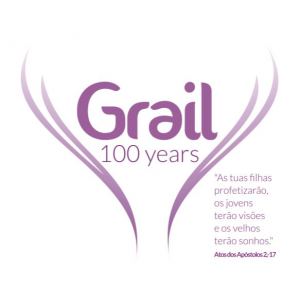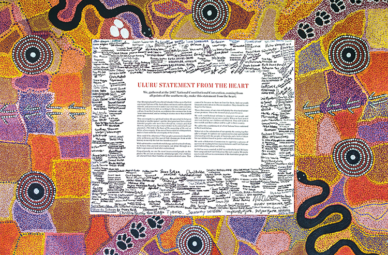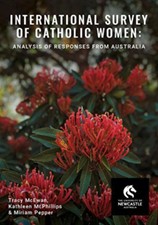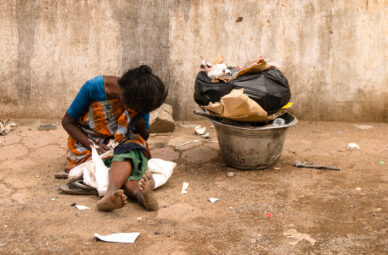A Hundred Years of Grail Spirituality
May 20, 2021
This is not an academic paper, it is a heartfelt reflection on the little that I know of Grail history, life and spirituality over the past 100 years. It is like looking at a few of the threads in a huge and colourful tapestry.
In 1921, Father Jacques van Ginneken, a Dutch Jesuit priest, founded the Women of Nazareth. At its beginning, it was a lay movement of young women who made a lifelong commitment to a simple and celibate community life dedicated to the conversion of the world. It had a strong missionary impetus, but conversion of the world was not so much about converting people to Christianity as it was about building the Kingdom on earth in very real social and political ways. Van Ginneken believed in the strength and the talents of women, and it was to encourage and develop these, particularly within the Catholic Church, that he founded the Women of Nazareth. These women would be responsible for training lay Catholic women to become creative and active in the lay apostolate. 100 years later, formation of women remains one of our strongest attributes.
The Women of Nazareth themselves were formed by van Ginneken in decidedly traditional religious ways: they underwent a long period of formation, lived prayerful and ascetic lives in quasi-monastic communities and dedicated themselves with promises of poverty, chastity and obedience. It was, in many ways, a heroic life. It’s not surprising that when van Ginneken had to find a name for the youth movement that the women started in 1928, he looked for something that was evocative of heroism. And so the Grail movement came into being.
It was an inspired choice for a name. Rachel Donders once said that “our togetherness is in the Grail quest.” Who in the Grail has not meditated on this legend many times? And Sally Timmel told it to us once again at our 100-year celebration on Zoom last year. The Grail, she said, is the symbol “of the mysterious link between heaven and earth, of the presence of the divine within the ordinary things of everyday life.” And for us, the story poses the crucial questions we return to, again and again. In Sally’s words, “What is the cause of all the suffering in our world? What and who are we as the Grail? And whom does the Grail serve?” Across the span of 100 years, and across the countries of the globe today, we remain united by these questions of the Grail legend.
Already, in the story so far, we can recognize ourselves 100 years on.
If you want to understand more of our Grail history, culture and spirituality, from these beginnings until the 1980’s, read Women of Vision, by Marian Ronan and Mary O’Brien. It is an absolutely fascinating read. I will draw primarily from this resource in considering what I think to be key elements of the Grail in this era.
These were the great missionary expansion years, which began in the 1930’s. You know the story – I hope! What interests me is what drove and sustained our founding mothers. What stands out first and foremost is how much they were fuelled by faith – a conscious faith that they assiduously nurtured with study, reflection, prayer, liturgical celebration, and all manner of spiritual exercises and disciplines. These women had intense interior lives.
Mary Louise Tully recounted, “After visiting both the Grail in England and in Holland, I was captivated by the completeness of the dedication to Christ.” Bep Caminada remembered, “I went to see Margaret van Gilse. Since this was during the war... the situation was that the younger women were all hidden together in a convent and, I must say, that attracted me. I was drawn by the enthusiasm of these young people who were in hiding. There was something spiritual behind this and it was something I could really engage myself in…
So I spent the terrible last months of the war in an Ursuline convent near Haarlem…we studied Christian asceticism with Rachel. We were about fifteen in number…What inspired me was the spiritual side. It was a time of discovering spirituality and trying to live with God. For me, personally, it was a time of stopping, of really thinking and starting to meditate and pray and quiet down.”
Magdalene Oberhoffer thought, “The whole of the Grail is so active; we need personally and as a group to be rooted in an intense spiritual life. And for that we need prayer. Van Ginneken said that without this interior life of prayer we would lose our spirituality, since the Grail is not just a Catholic action movement – it is, first, a spiritual movement.”
At the IGA in 1988, at the Tiltenberg, Rachel Donders delivered a paper entitled The Grail – A Faith Community: Past, Present and Future. What she said then remains relevant today:
“We are talking about the Grail as a faith-COMMUNITY. This seems to mean that the faith experience is not just an individual thing but that there is from within that individual faith a full recognition of each other, a gravitation towards each other, a sharing. A faith community means, as I understand it, that we share faith experience, that we are geared towards that horizon together. This can be in words, in symbols, in action, in celebration. And isn’t that what the Grail is all about, sharing the faith dimension in ever-widening circles?”
We are women of faith, but we are equally women of action. When I read the stories of our founding mothers, I am in awe at what they achieved. Much of their work, as they expanded, was formation of women of one kind or another. Hilda Canters remembered, “In the early days we were mostly concerned with the conversion of the world. This was what Father van Ginneken emphasized. By the time we went to Burundi, in 1959, we just wanted to help all women…By then, I believed that the work of the Grail was to help women develop their own talents…” Developing the talents of women: another staple of Grail culture.
As for conversion of the world, Mimi Marechal explained, “What we called conversion in the early days is now transformation…That same urge to bring about change, which was essential to young women in the early days of the Grail, is still alive.”
That urge to bring about change, to make the world a better place, to build the kingdom, to ask the compassionate question, “What is your sorrow?” and to do something about it: all this remains integral to who we are.
There is one other significant thing I would like to highlight from these years. I will call it the openness to be changed by “otherness”, and the willingness to learn to live with difference. It was very much a teaching of Fr van Ginneken, as Hilda Canters tells it. “Father van Ginneken came and gave a big course, a two-week course, about the whole world…It was 1930…Father van Ginneken said, “You think now it is difficult to travel, but you will see that in the end, the world will be one big village and it will be very difficult for all kinds of people -of different educations- of different habits to live together.” So, he explained, he had founded the Women of Nazareth to practice living together with people from different nations. And that in our group we would learn to live, all kinds of cultures together. And that that would be very difficult. But you are with the Lord, he told us, and with the Lord you will manage it.”
Bep Caminada told it like this: “When I look back on my whole experience of thirty years in Brazil, I realize that the people I worked with appreciated more than anything else that I was with them, that we worked together. What helped me and the Grail was the continuous insistence on discovering more about them and their country and having patience in trying to achieve. We had to realize that we were in a completely different situation and we had to wait and learn about how to start the Grail.
This meant that I had to drop a lot of my own baggage – cultural, spiritual and theological – and accept the simplicity of their ways.”
The same happened in Africa, according to Magdalene Oberhoffer: “We were very well accepted in Africa. This, I am sure, was because of our approach, our immersing in the culture and respecting it, learning their language, listening to their needs and forming our work around these and not our assumptions.
Eventually, those of us from Europe and the U.S. had to recede into the background, which is the modern approach. This is very Grail.”
By the end of the formation and foundation years the Grail had emerged as a Catholic faith community of women, consciously championing the dignity and rights of women, dedicated to transforming the suffering of the world, and working effectively across social and cultural divisions in doing so.
This remains a good working definition of the Grail movement and it’s the one I use when trying to describe it to someone who asks. But it doesn’t capture the Grail spirit. This is, as I reflect on it, a spirit of restlessness, of voracious appetite for life, of reading the signs of the times and moving forward with them. We embraced Vatican II, and ecumenism became a significant impetus within the Grail. We expanded our thinking with liberation theology, feminist theology and, more recently, eco-theology. In 2011 our vision statement says we are “women of various religious traditions and on life-giving spiritual journeys.”
But don’t let’s get ahead of ourselves. I cannot move on from our foundational years without saying something about both the Tiltenberg and Grailville. The Tiltenberg in the Netherlands was the first large-scale place of formation for Grail women, at first particularly for those women wanting to dedicate their lives to the Grail. Rachel Donders, one of the first young women to be trained there in the early ’30s, had this to say: “We had lectures by Father van Ginneken, we had a lot of time for prayer, and we did a lot of singing. At table, we always had readings on the spiritual life, usually about the virtues. It was the old spirituality, but we took it seriously.
We also worked very hard cutting trees and washing dishes, and there was lots of silence. Since we were all young, we found it wonderful and easy…It was a simple life. We were a group of women with our own leadership and our own spirituality.”
It was also a place for spiritual retreat and refreshment. Before Frances van der Schott embarked on a journey to start the Grail in Australia, she went to the Tiltenberg to spend a few months there in prayer and silence.
As for Grailville, so many Grail women speak of their time there as one of the defining moments of their lives, and, like the Tiltenberg, the experience was what drew them into a lifetime commitment. Grailville began in 1944 on a large farm in Loveland, Ohio.
Lydwine van Kersbergen, one of the founders of Grailville, found there the integrated life that she had always been searching for, “training, the liturgy, the land,” as she put it. The training was rigorous, the lifestyle as disciplined and ascetic as any monastery, the work on the land was hard, but the liturgical life, following the rhythms of the seasons of both the earth and the Church, was deeply satisfying, and there was plenty of intellectual stimulation provided by invited speakers who were at the forefront of the Catholic lay apostolate. There was also a rich cultural life that included readings of plays and the works of great Catholic writers, the arts were encouraged, and there was even religious dance. Like a Benedictine monastery, Grailville was a place of work, study and prayer, but imbued with youthful idealism, creativity and enthusiasm.
I think it is safe to say that we all carry the legacy of the Tiltenberg and Grailville today, no matter what country we are in. They are in our collective DNA. The Tiltenberg was sold in 2003 and Grailville no longer functions as it once did. These sad realities reflect changing times. It looks like growth and expansion in the Grail has come to an end in Europe and America, at least for the time being.
I would like to make a personal reflection at this point. Reading the stories in Women of Vision can engender a sense of envy. What is it, I wonder, that is enviable here, and what does that say about us? Is it the totality of their commitment that we envy? Or is it the integrated life that Lydwine found at Grailville, that disciplined but deeply satisfying balance between prayer and everyday experience? Is it the simplicity of their lifestyle? Or the solidarity? Or is it something else again?
I would now like to relate my own personal experience of Grail life and spirituality. I first met the Grail in 1980 when I joined a group of young professional women interested in learning more about injustice in society. The group met once a month at the Sydney Grail Centre with Ruth Crowe as our teacher and guide. Like Grail women before her, Ruth was forming young women to make a difference in the world. She was the first but by no means the last of Grail mentors and guides in my life.
I was just starting out as a teacher in high school and up until that time my Catholic faith was still very much about personal holiness and getting to heaven, as inculcated in me by numerous nuns and priests over the years. The Grail was to play a large part in changing that – in opening my eyes not only to the sad realities of systemic injustice but in developing my social conscience as an integral part of my faith.
It’s now 40 years on. What can I say about Grail life and spirituality as I have known it?
It’s about women forming other women, accompanying them in the journey of their lives, relationships that go deeper than friendship.
It’s about engagement with the suffering of this world and seeking to do something useful about it. It’s about caring for the weak in society, the disadvantaged, the voiceless.
It’s about the talents and strengths of women being valued, nurtured, encouraged and supported.
It’s about a deep love for the person and teachings of Jesus Christ, developed through studying Scripture and theology together, and creating and participating in prayerful liturgies.
It’s about lifelong learning, desiring to read the signs of the times.
It’s about restless searching forever deeper truth, for living in the Mystery.
It’s about generous hospitality, welcoming the stranger, feeding the multitudes.
It’s about respect for diversity, really listening to one another, about dialogue and discernment. Anyone who has ever been at a Grail meeting knows that the talking is endless, but that is because we listen. We create safe space for people to express themselves honestly.
It’s about interfaith understanding and dialogue, eco-theology and care for the earth, training for transformation, non-violence and peace making.
If I were to critique this Grail spiritual culture that I have lived with for 40 years, I would say this. We try to do so much and sometimes that so much becomes too much. We often spread ourselves thin in too many directions. It’s a function of our voracious appetite for life and for reaching out to others, and the fact that we allow everyone responsibility for creating new projects, but it can come at a cost. Burnout is one of them. Less effectiveness can be another. And we risk failing to attend to what is most important, sometimes right in front of our eyes.
This is my experience of a lifetime of searching shared with Grail women.
What is yours?
I am going to jump now to the Grail in the 21st Century, to the Spirituality Forum held in Palmela, Portugal, in August 2007. Looking at the seven-day program, one can get an insight into the spirituality topics that were of most concern to us at that time. And what were they?
Day One was culture, spirituality and the challenges of inculturation, day two the voice of youth, day three explored mysticism, day four human suffering, day five was about Eucharist, day six eco-spirituality, and day seven touched on interfaith dialogue.
No surprises, really. I was not able to go to this forum, but I treasure the Spirituality Forum Resource Booklet compiled by forum participants from the Sydney Grail, and every so often I dip into it as a precious well of living water.
After this forum the Grail Theological Resource Workgroup came into being and was very active between 2009 and 2013. You can see the results of their work on the International Grail website. Go to What We Do, then Spirituality Network, then Txintxa process. What was Txintxa? I quote from the website, “Txintxa’ is a Xangana word from the south of Mozambique; it comes from the verb ku txinxa,“to change.” It is used as a slogan when a community starts a work project together: changing a hut roof, planting a vegetable garden…. Txintxa supposes a movement and a change that result from a collective effort.” Over the course of five years, the workgroup facilitated and co-ordinated a global conversation on topics deemed of major importance in the Grail. Round 1 studied our Christian origins, round 2 looked at cultural changes and spiritual challenges. Round 3 was on ecumenism and round 4 on interreligious understanding.
I was co-opted somewhere along the way and became responsible for reading all the Round 3 responses on ecumenism and producing a coherent summary. I need to say that the Eucharist was clearly a major sticking point. If you look at Round 4 of Txintxa on the website, you will see that Anne Hope wrote a beautiful reflection on Eucharist as a resource to stimulate further understanding and conversation within the Grail. But on a practical level, sometimes when we gather as Grail these days, and particularly when we gather as an international ecumenical community, there is tension and pain when it comes to celebrating the Eucharist. The Catholic mass is no longer the sacrament that unites us, but rather the sacrament that divides us. We are aware of this reality but we have made no concerted effort so far to come to any completely satisfactory arrangement. This is spiritual work of deep discernment, and dare I say it, painful letting go, which we need to do. Within the Grail today, this is our sorrow. We must ask ourselves the compassionate question and we must listen to the answers.
If you weren’t at the International General Assembly in Fatima in 2017, as I was, I hope nonetheless that you have read the talk that Marian Ronan gave at that assembly - Challenges Facing the Grail in Its Second Century: Burning with the Passion of the Founders. I had really wanted Marian to be the one speaking to you tonight on 100 years of Grail spirituality – she is far more knowledgeable and experienced than I am. However, Marian is an extremely busy woman and she suggested I do it instead. So here I am. I suspect that Marian, like me, envies the passion of our founders. Rigorous formation, charismatic faith, passion and hope are all words that get a good workout in her powerful essay. As for challenges, Marian singles out and deals with two – climate change and war. However, it is her closing remarks that I find most challenging. I quote at some length: “Finally, let me suggest that for the Grail Movement to respond with the passion of our founders to these two massive global challenges, we must face a third, internal challenge: the revival and intensification of Grail formation.
Much has changed since Father van Ginneken mandated rigorous spiritual and intellectual formation for the Women of Nazareth. Today, not all our leaders feel called to make promises of poverty, chastity and obedience. But the challenges confronting us today are, if anything, even more serious than they were in 1921. So clearly, for the Grail to respond to these challenges, we need more than ever the passionate dedication and knowledge that energized our foremothers. And to develop that passion and commitment, we need strong, ongoing formation.
I fear that in some places, twentieth-century individualism has made us reluctant to place the kind of demands on one another and on new Grail members that were an essential part of the early Grail. I challenge us, then, to commit ourselves to a renewed, powerful, and ongoing Grail formation process. Why is this so important? Because only with such rigorous formation will we be able to carry out the mission to which God calls us—the transformation of the world.”
Can you see that I have come full circle? Formation is perhaps the brightest of all threads in our beautiful tapestry. Let us not forget, however, that at the heart of this formation in the beginning was an intense prayer life, both individual and communal. And above all, there was the Eucharist. Today the Eucharist has become a stumbling block for our global ecumenical movement, if not for our regional groups. This is something we need to acknowledge and address. At the same time, perhaps, we could address the whole question of the prayer life of the Grail, now that we no longer have a common Catholic tradition to draw on.
Is it possible to foster a common prayer life in a global community that includes women of diverse faith and religious belief, and, if so, how do we do it? This is too big a subject for me to canvas at any great length here. My simple suggestion at the last IGA was that we recite the Vision Statement each day and hold our Grail sisters in our hearts for a few minutes. My own inclination would have us go much deeper than this, into practices that take us into silence and contemplation of the Mystery we believe in. But these conversations are for another day.
And if I am permitted to make some comments about the future of Grail spirituality?
There are golden threads running through our history and they will continue. Unity in diversity is one of them, and we must find a way around the problem of the Eucharist. We must continue our efforts in “renewed, powerful and ongoing Grail formation” as Marian says. Perhaps this could include a new conversation on the place of prayer in the life of the Grail?
We are well skilled in the art of reading the signs of the times. And what are they? Climate change and war are truly apocalyptic challenges in our time. Since Marian spoke at the IGA, scientists are now increasingly warning that we may have passed the point of no return with global warming, with many feedback loops already in motion. Wars will be fought over water and other scarce resources. Science tells us we may be facing the end of civilization as we know it. Human extinction is a distinct possibility.
We are also still in the grip of a global pandemic. We have known fear, loss and uncertainty in very real ways. We have been confronted with human suffering on every continent.
May I suggest that, in the light of all this, we turn to Pope Francis and his latest encyclical, Fratelli Tutti? It is worthy of our closest study and meditation. He calls for a culture of encounter and a culture of care. In that respect, his encyclical encapsulates the spirit of the Grail as we have tried to live it for one hundred years. What Francis especially brings to this teaching is his emphasis on the virtue of compassion, as demonstrated so well by the good Samaritan. It is compassion that we need now, more than ever.
From where I sit, looking at our 100 years of history and being attentive to the signs of the times, I believe that now is a time we need to slow down, be still and listen. The perennial questions still serve us well. “What is the cause of all the suffering in our world? What and who are we as the Grail? And whom does the Grail serve?” Like Parsifal we need some time in the wilderness. It is from there that we might be able to see more clearly the compassionate response to a dying world.
Magdalene Oberhoffer once said, “The experience of belonging to such a warm-hearted, deeply motivated international family like the Grail always fills me with joy and gratitude.” Writing this paper has been for me a profound experience of feeling truly at home in the Grail family, and I too am filled with joy and gratitude. I wish you the same.
Patricia Gemmell
Sydney
April 2021
Patricia has a Masters in Theology and is a member of the Australian Grail National Leadership.











